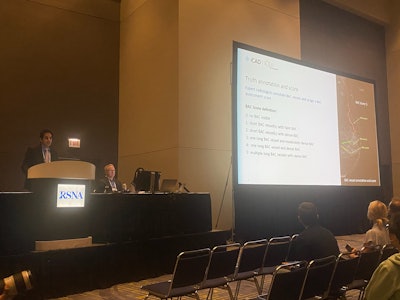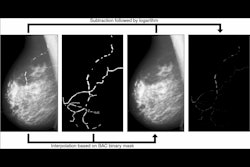CHICAGO -- AI-based breast arterial calcification (BAC) detection on mammography is feasible and accurate, according to research presented November 28 at the RSNA 2023 annual meeting.
In his presentation, Chirag Parghi, MD, from Solis Mammography discussed his team’s findings, which found that its algorithm showed high accuracy in BAC detection. This included a prevalence and distribution of BAC increasing with age in a screening population.
“The reality is women are being diagnosed with heart attacks at an unprecedented rate,” Parghi said. “We poorly understand heart disease in women and who among women will get heart disease. We have a finding on a mammogram that can find women who can benefit from additional cardiovascular surveillance.”
BACs have traditionally been evaluated as BI-RADS 2 lesions, often meaning no treatment is recommended. However, previous reports suggest that these benign findings are tied to the risk of developing type 2 diabetes, high blood pressure, and inflammation, as well as being a biomarker of stiffening in the arteries.
Parghi and colleagues analyzed the accuracy and feasibility of using AI to detect and assess BAC on mammography in a large screening population across 15 sites. In their prospective study, the researchers included 2D mammography data from 117,189 asymptomatic women undergoing screening during a one-month period in 2023. The study assessed the overall prevalence and distribution of BAC across four age groups: < 50, 50-59, 60-69, and ≥ 70 years.
The team trained the AI model using an internal real-world dataset of 2D mammograms to detect BAC based on expert annotation. The model provides an assessment score of 0-5 for BAC according to the total area of BAC and its density. The team validated the algorithm’s accuracy on a dataset of 2D mammograms from 8,898 women. It also noted that there is no overlap between the training, validation, and the 117,189 women in prospective study datasets.
 Chirag Parghi, MD, from Solis Mammography presented research at RSNA 2023 showing the efficacy of an AI model in detecting breast arterial calcifications on mammography.Amerigo Allegretto
Chirag Parghi, MD, from Solis Mammography presented research at RSNA 2023 showing the efficacy of an AI model in detecting breast arterial calcifications on mammography.Amerigo Allegretto
The researchers found that their algorithm achieved a high area under the curve (AUC) value of 0.938 on the validation set, indicating high accuracy. They also found in the prospective study that the overall prevalence of BAC detected by the AI algorithm was 14.8%.
This included a prevalence of 4.2% in women younger than 50 years old, 9% in women ages 50-59 years, 19.9% in women ages 60-69 years, and 40.7% in women ages 70 and above, with a BAC score greater than 1.
Parghi said that the results suggest that AI can standardize BAC detection, as well as improve efficiency and reduce interobserver variability. He added that the age-specific prevalence of BAC could help better inform clinical decision-making and risk assessment with an expectation of patient volumes.
In April, the team collected data from 15,785 women. That increased to 59,701 women in July and 117,189 in November. For all time points, BAC prevalence ranged from 14.8% to 15.0%, showing relative consistency.
“At scale, it’s a pretty impressive opportunity for us as breast imagers to think beyond breast cancer detection, but overall women’s health,” Parghi said. “I really think we all should be reporting this. AI tools are the perfect opportunity to allow us to continue our work as we are understaffed and backlogged from reading screening mammograms.”
This study was performed as part of a partnership between Solis Mammography and iCad.



















